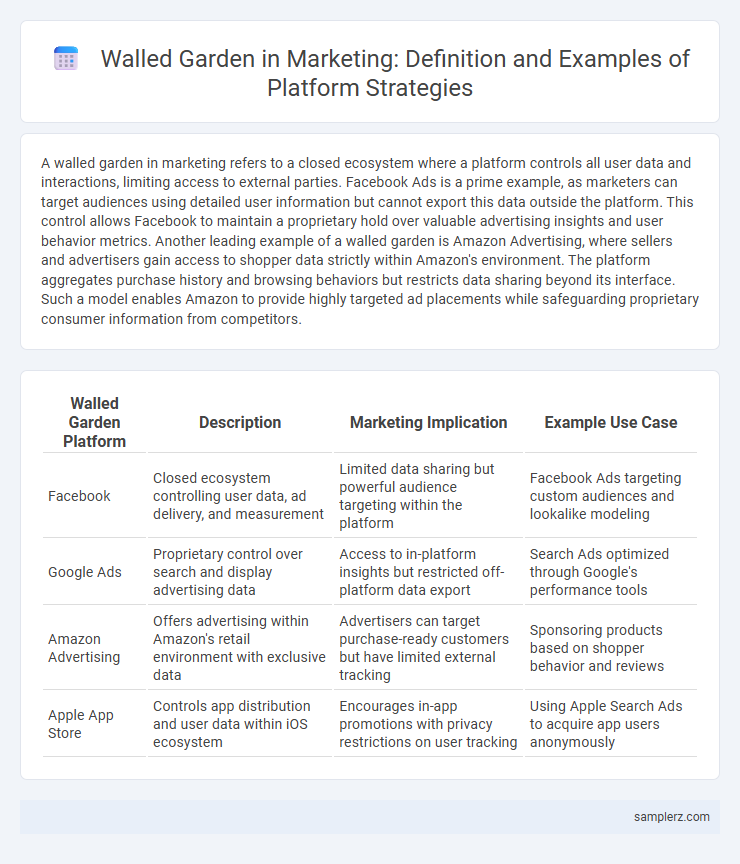A walled garden in marketing refers to a closed ecosystem where a platform controls all user data and interactions, limiting access to external parties. Facebook Ads is a prime example, as marketers can target audiences using detailed user information but cannot export this data outside the platform. This control allows Facebook to maintain a proprietary hold over valuable advertising insights and user behavior metrics. Another leading example of a walled garden is Amazon Advertising, where sellers and advertisers gain access to shopper data strictly within Amazon's environment. The platform aggregates purchase history and browsing behaviors but restricts data sharing beyond its interface. Such a model enables Amazon to provide highly targeted ad placements while safeguarding proprietary consumer information from competitors.
Table of Comparison
| Walled Garden Platform | Description | Marketing Implication | Example Use Case |
|---|---|---|---|
| Closed ecosystem controlling user data, ad delivery, and measurement | Limited data sharing but powerful audience targeting within the platform | Facebook Ads targeting custom audiences and lookalike modeling | |
| Google Ads | Proprietary control over search and display advertising data | Access to in-platform insights but restricted off-platform data export | Search Ads optimized through Google's performance tools |
| Amazon Advertising | Offers advertising within Amazon's retail environment with exclusive data | Advertisers can target purchase-ready customers but have limited external tracking | Sponsoring products based on shopper behavior and reviews |
| Apple App Store | Controls app distribution and user data within iOS ecosystem | Encourages in-app promotions with privacy restrictions on user tracking | Using Apple Search Ads to acquire app users anonymously |
Introduction to Walled Gardens in Digital Marketing
Walled gardens in digital marketing refer to closed platforms like Facebook, Google, and Amazon that control user data, content, and advertising environments within their ecosystems. These platforms restrict data sharing with external parties, offering marketers limited transparency but comprehensive targeting capabilities and analytics. Understanding the walled garden model is essential for optimizing ad campaigns and navigating challenges related to data privacy and measurement attribution.
Defining Walled Garden Platforms
Walled garden platforms, such as Facebook and Amazon, are digital ecosystems where access to data and user interactions is tightly controlled, limiting third-party integration and data sharing. These platforms create closed environments that prioritize user engagement and privacy while restricting marketers' ability to access comprehensive cross-platform analytics. By operating within walled gardens, advertisers must navigate proprietary tools and algorithms, often relying on platform-specific ad targeting and measurement solutions.
The Role of Walled Gardens in Marketing Strategies
Walled gardens like Google, Facebook, and Amazon control vast ecosystems that limit data sharing while offering precise audience targeting and measurement tools for marketers. These platforms enable advertisers to leverage first-party data, enhancing campaign efficiency and return on investment within a secure environment. Marketers relying on walled gardens benefit from integrated analytics and user insights that drive personalized advertising strategies and optimize customer engagement.
Facebook as a Leading Walled Garden Example
Facebook exemplifies a leading walled garden platform by controlling user data, ad targeting, and content distribution within its ecosystem. Its proprietary algorithms and closed data environment enable advertisers to access detailed audience insights while restricting external data integration. This containment maximizes ad effectiveness, user engagement, and revenue generation, distinguishing Facebook's marketing model from open web methods.
Google’s Walled Garden Ecosystem
Google's Walled Garden Ecosystem includes platforms like Google Search, YouTube, and Google Ads, where data access is tightly controlled to optimize targeted advertising and user experience. Advertisers benefit from comprehensive insights within Google's environment but face restricted data portability outside its platforms. This controlled ecosystem enhances ad precision while maintaining user privacy through proprietary algorithms and data management.
Amazon’s Walled Garden in E-Commerce Marketing
Amazon's Walled Garden in e-commerce marketing restricts data access to protect user privacy while enabling advertisers to leverage first-party data for targeted campaigns. This closed ecosystem allows Amazon to control shopper insights, optimize ad placements, and deliver personalized advertising within its platform, driving higher conversion rates. Marketers benefit from Amazon's comprehensive sales and behavioral data, gaining precise audience targeting that is unavailable on open web environments.
Apple’s Controlled Advertising Environment
Apple's controlled advertising environment exemplifies a walled garden by restricting third-party access to user data across its platforms such as iOS and macOS. Advertisers must rely on Apple's SKAdNetwork for privacy-focused attribution, limiting granular insights but enhancing user privacy protection. This closed ecosystem allows Apple to maintain strict control over ad delivery and measurement while safeguarding consumer data within its proprietary infrastructure.
TikTok and the Emerging Walled Garden Model
TikTok exemplifies the emerging walled garden model by controlling user data, ad placements, and content distribution within its ecosystem, enhancing advertiser targeting precision. Its closed platform restricts third-party data access, creating a self-contained environment that maximizes engagement metrics and monetization opportunities. This approach reflects a shift in digital marketing strategies, emphasizing platform-specific audience insights and streamlined campaign management.
Implications of Walled Gardens for Advertisers
Walled gardens such as Facebook, Google, and Amazon control vast amounts of user data while restricting advertisers' access to external tracking and cross-platform measurement. This limits advertisers' ability to perform comprehensive attribution analysis and optimize campaigns beyond the platform, often forcing reliance on proprietary metrics. Consequently, marketers face challenges in achieving transparency, data portability, and truly holistic audience insights.
Future Trends of Walled Gardens in Digital Platforms
Walled gardens like Facebook, Amazon, and Apple increasingly dominate digital advertising by controlling user data and limiting third-party access, shaping future trends in personalized marketing. These platforms leverage advanced AI algorithms and proprietary data to enhance audience targeting and campaign measurement while restricting interoperability with external tools. Expect ongoing growth in closed ecosystems prioritizing user privacy and integrated advertising solutions, driving marketers to adapt strategies within these controlled environments.

example of walled garden in platform Infographic
 samplerz.com
samplerz.com